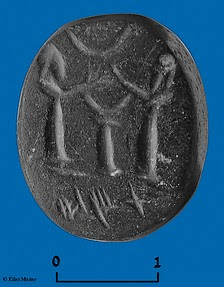When we were in Israel during the summer of 2007 I took the following slide show of photos of the excavated eastern wall of the ancient City of David, or the original Jerusalem. Excavation and these photos reveal:
- the Jebusite wall (1100 BC) of the city that David and Joab took from the Jebusites around 1003 BC
- dwelling places, or residences, on the outside of the city wall (1000-600 BC)
- the southern and northern towers on the wall built during the time of the kings of Judah (1000-600 BC)
- portions of the wall that Nehemiah rebuilt (445 BC)

I was excited to see that in this month's issue of
Biblical Archaeology Review there was an article by
Eilat Mazar who discovered David's palace in 2005. She is a third-generation Israeli archaeologist and granddaughter of the legendary Benjamin
Mazar. In this article she describes some of the finds from her work in and around the ancient royal palace of Judah's kings:
- A section of Nehemiah's wall
- Seal impressions featuring scenes and names of some people mentioned in the Bible
- A building now called the Large Stone Structure with walls between 7-11 feet thick at the high point of the City of David believed to be David's palace.
- Two towers, the Southern and Northern Towers, which sit just a few feet away from David's palace.
- A bulla (an impression made in clay with a seal) that bears the name Yehuchal ben Shelemyahu, or Jehucal son of Shelemiah, found in David's royal palace mentioned in Jeremiah 38:1 and 37:3. In Jeremiah 38 Jehucal accused Jeremiah and helped lower and confine Jeremiah in a cistern. In Jeremiah 37:3 Jehucal was sent by the King along with a priest to ask Jeremiah to pray for the crumbling nation.
- A bulla found underneath the northern tower that bears the name Gedalyahu ben Pashhur or Gedaliah son of Pashhur, who is also mentioned in Jeremiah 38:1 as assisting in Jeremiah being confined to a cistern in the courtyard of the guard. In Ezra 2:38 the family of Pashhur returns to Jerusalem from Babylonian captivity and is listed with the names of the priests. (Note: these two men, Jehucal and Gedaliah, are mentioned in the same verse in Jeremiah 38: 1 and are described as working together in the royal palace against Jeremiah. Now,sometime during the last few months, since I was in Jerusalem and had a chance to look at Mazar's excavation, bullae with the names of these same two men impressed along with their family names have been found within a few feet of each other in the same royal palace the Bible says they worked!)
- Bronze and iron arrow heads from the Babylonian destruction of Jerusalem in 586 BC where mixed in with stone weights, clay figurines and bullae (clay seal impressions).
- Pottery from a stratum from the Babylonian period between 586-538 BC
- A seal carved in a shiny black stone engraved with a Babylonian religious scene with the name Shelomit engraved in Hebrew . Shelomit was the daughter of Zerubbabel. Zerubbabel was the heir to the royal throne of Judah who returned to Jerusalem to serve as governor under the Persian Empire. He would have taken up residence in a rebuilt royal palace.
These are interesting finds that help confirm the historical accuracy of the Old Testament. I refer to the value of finds like this in my latest book
Framework for Christian Faith on page 21:
When there is not much evidence to support an event recorded in Scripture, then negative evidence is of small account. For example, if there is little physical evidence to prove or disprove that Noah built an ark, the fact that we do not physically have Noah's ark does not prove that it did not happen. When evidence and information on a subject is lacking, the smallest amount of support will carry great weight. If we were to find an ancient inscription that included Noah's name or made some geological or archaeological discovery that supported the Flood story of Genesis, these would support the validity of the Flood narrative, and the whole book of Genesis.
Skeptics will claim, "Archaeologists have shown the Bible to be a legend at best." With discoveries like the finding of David's palace, Nehemiah's wall,
bullae with the names of biblical personalities, remains of the Babylonian destruction and much more the critics have to admit that archaeology continues to be on the side of proving the validity of the Bible.

The "Shelomit" Bulla, daughter of Zerubbabel

Gedaliah' Bulla; he confined Jeremiah to a cistern
Galyn Wiemers
http://www.generationword.com/
 The "Shelomit" Bulla, daughter of Zerubbabel
The "Shelomit" Bulla, daughter of Zerubbabel Gedaliah' Bulla; he confined Jeremiah to a cistern
Gedaliah' Bulla; he confined Jeremiah to a cistern